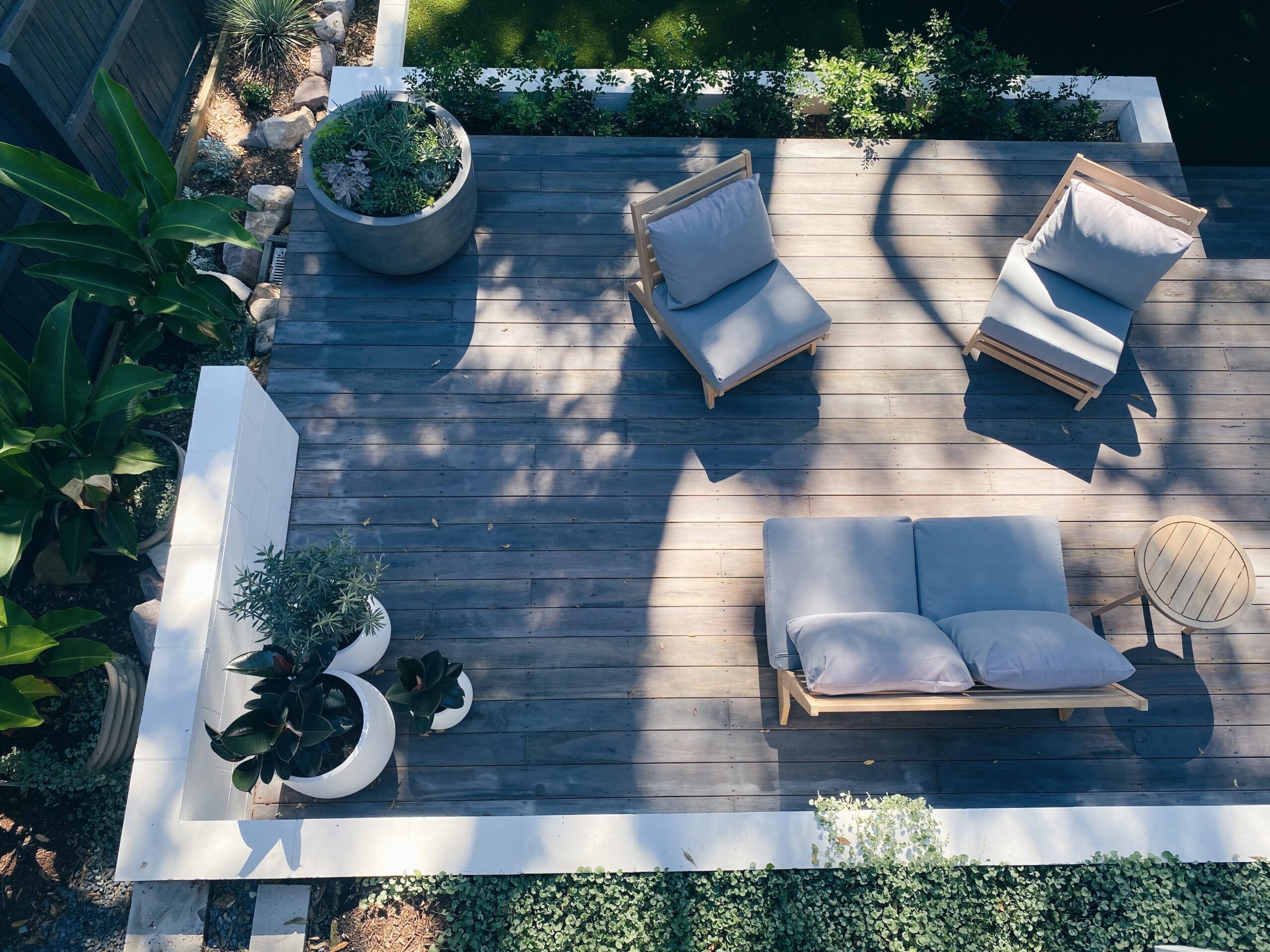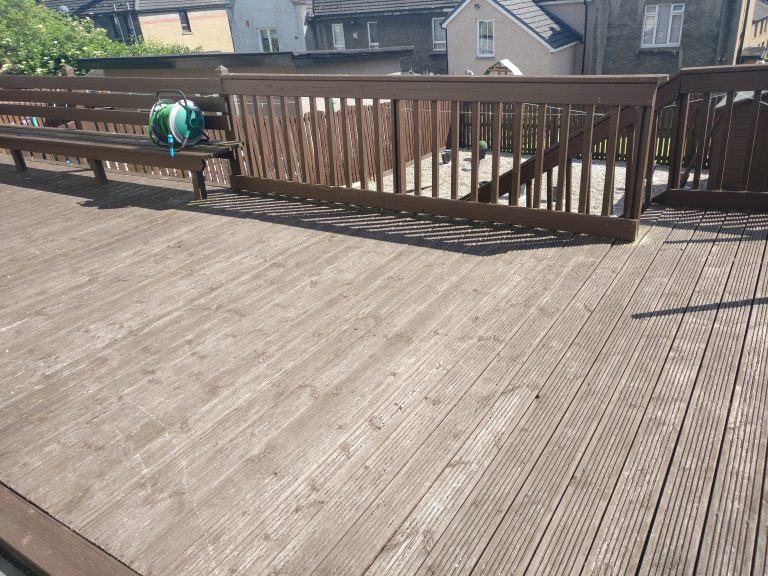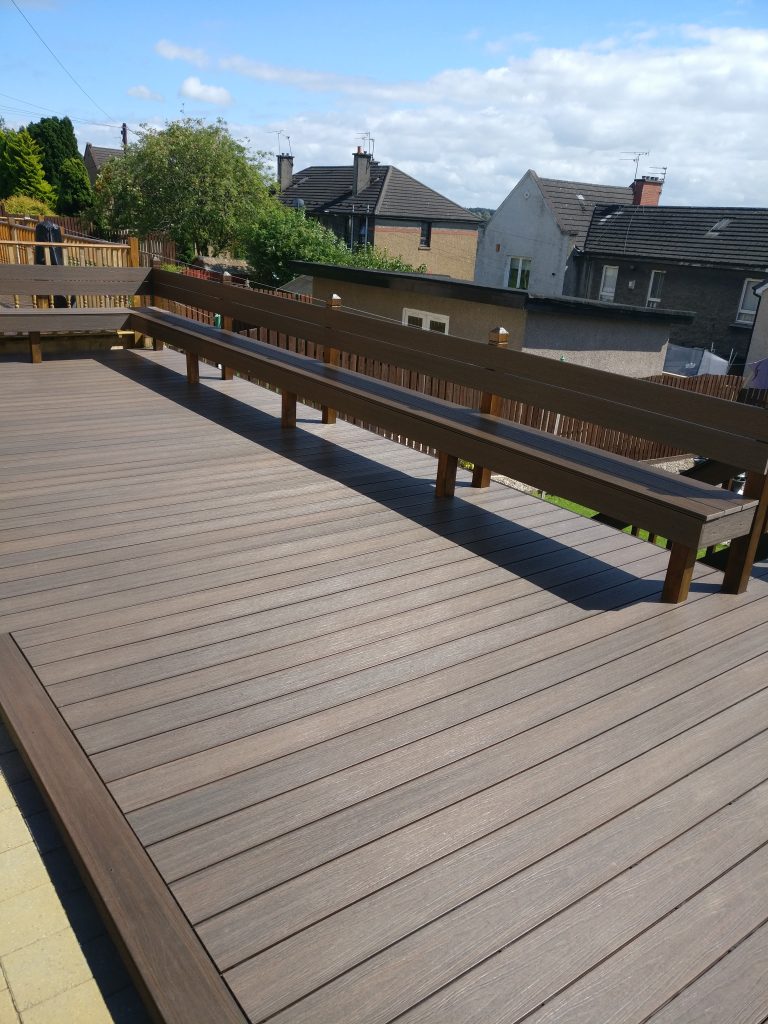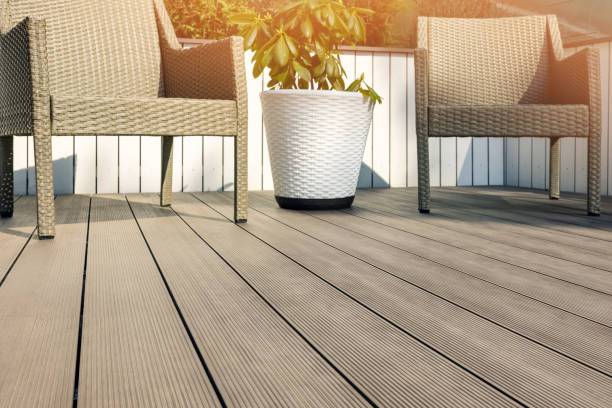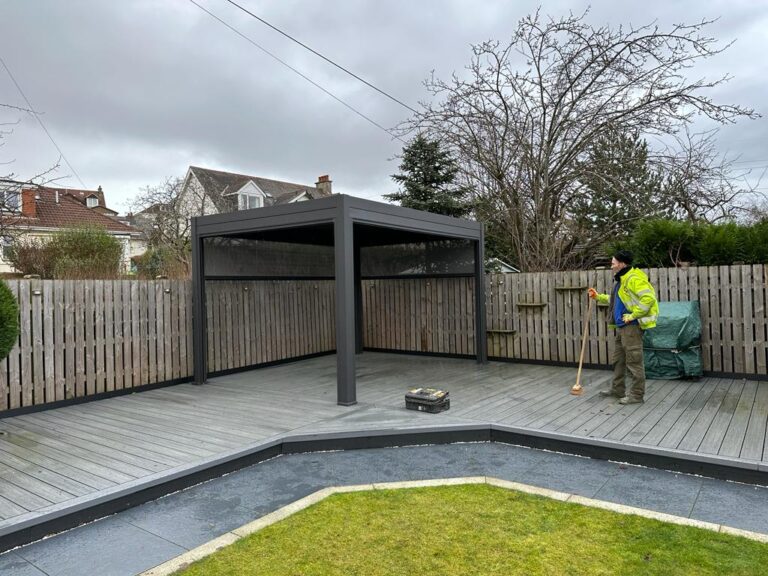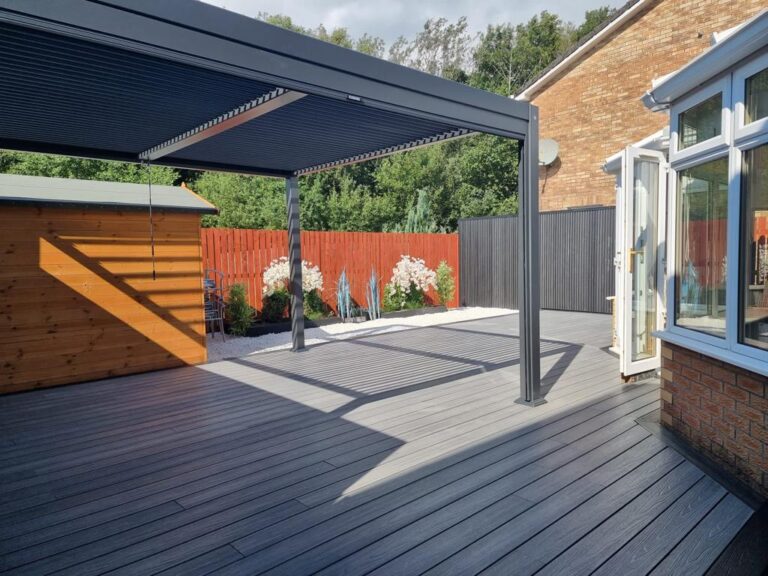Composite decking has become increasingly popular as a durable and low-maintenance alternative to traditional wood decking. With its long-lasting properties and minimal upkeep requirements, many homeowners are turning to composite decking for their outdoor living spaces.
One common concern that arises is whether it’s safe to place heavy furniture on composite decking. In this article, we will explore the different types of composite decking, how it differs from wood decking, the advantages and disadvantages, as well as the weight limits and risks associated with placing heavy furniture on composite decking. We will provide tips on how to protect your decking from potential damage and alternatives to consider when dealing with heavy furniture. By the end of this article, you’ll have a comprehensive understanding of the considerations involved in placing heavy furniture on composite decking, enabling you to make informed decisions for your outdoor space.

What Is Composite Decking?
Composite decking is a modern, innovative building material composed of a blend of wood fibres, recycled plastics, and bonding agents, designed to provide a durable and low-maintenance alternative to traditional wood decking.
Manufactured through a carefully controlled process, composite decking offers a unique blend of resilience and aesthetics. The wood fibres and recycled plastics are combined with bonding agents under high pressure and temperature to create a strong, stable material that resists warping, splintering, and rotting. This ensures that composite decking maintains its beauty and integrity for many years, requiring minimal upkeep. The use of recycled materials makes it an environmentally friendly choice, reducing waste and promoting sustainability in building practices.
What Are the Different Types of Composite Decking?
Composite decking comes in various types, including:
- Capped composite
- Uncapped composite
- Wood-plastic composite (WPC)
each offering distinct features and benefits based on their material composition and design.
Capped composite decking combines a durable composite core with a protective polymer shell, providing exceptional resistance to stains, fading, and mould. On the other hand, uncapped composite decking, while equally durable, may require occasional maintenance to prevent moisture absorption.
WPC decking, made from a blend of wood fibres and recycled plastic, offers a natural wood-like appearance with the added benefit of being eco-friendly. These different types of composite decking cater to various outdoor living spaces, offering a low-maintenance yet visually appealing alternative to traditional wood decking.
How Is Composite Decking Different from Wood Decking?
Composite decking’s make-up of recycled wood fibres and plastic components gives it increased durability over traditional wood, making it less susceptible to rot, mould, and insect damage. Unlike wood decking, composite materials are designed to withstand harsh weather conditions without warping, fading, or splintering, ensuring long-lasting performance.
The minimal maintenance needed for composite decking, compared to regular sealing and staining required for wood, allows for more leisure time and less expenditure on upkeep. These advantages make composite decking a practical and sustainable choice for modern outdoor settings.
What Are the Advantages of Composite Decking?
Composite decking offers numerous advantages, including exceptional durability, minimal maintenance requirements, and superior resistance to potential damage from environmental factors, making it an ideal choice for outdoor living spaces and furniture placement.
With composite decking, homeowners can create stunning outdoor entertainment areas that seamlessly blend with the natural surroundings. The range of colours and finishes available in composite decking allows for endless design possibilities, enhancing the aesthetics of any property.
Its resistance to mould, mildew, and insects ensures that outdoor living spaces remain beautiful and functional for years to come, without the need for constant upkeep.
What Are the Disadvantages of Composite Decking?
Despite its advantages, composite decking has some drawbacks, such as the potential risk of warping, sagging, and reduced moisture resistance over time, which can impact its structural integrity and long-term performance in outdoor settings.
Excessive load capacity or uneven weight distribution can further exacerbate these issues, leading to potential failures and safety concerns. Whilst composite decking is generally durable, prolonged exposure to harsh outdoor conditions can still affect its lifespan.
It’s important for consumers to carefully consider the specific usage and environmental factors when choosing decking materials to mitigate these potential disadvantages.
Yes, you can place heavy furniture on composite decking.
Placing heavy furniture on composite decking is possible, but it requires careful consideration of the weight limit and load-bearing capacity of the decking material to avoid potential damage and ensure structural integrity. Composite decking is designed to support a significant amount of weight, but exceeding its load capacity can result in warping, sagging, or even structural failure. To safeguard against these risks, it’s crucial to distribute the weight evenly across the decking surface, minimising pressure points that could lead to permanent indentations. Using protective pads or furniture glides under the legs of heavy items can further reduce the risk of damaging the decking material. It’s essential to be mindful of weight distribution and take necessary safety precautions to preserve the longevity and appearance of the composite decking.
What is the weight limit for composite decking?
The weight limit for composite decking varies based on the specific product and manufacturer guidelines, with typical load capacities designed to support standard garden furniture and ensure structural stability under normal usage.
Factors that influence the weight limit of composite decking include the materials used in its construction, the design of the support structure, and adherence to safety standards. Manufacturer specifications play a crucial role in determining the maximum allowable weight, as different composite decking products may have varying load capacities.
Proper weight distribution, regular maintenance, and avoiding excessive and concentrated loads also contribute to maintaining the decking’s safety and durability over time.

What Are Some Tips for Placing Heavy Furniture on Composite Decking?
Placing heavy furniture on composite decking requires specific considerations, such as distributing the weight evenly, using furniture pads or glides, and avoiding actions that may cause potential damage or compromise the decking’s structural integrity.
This ensures that the load is spread out across the decking, reducing the risk of indentations or stress points. Utilising furniture pads or glides under the legs of the furniture also helps to minimise direct contact and friction with the decking surface. It’s important to adhere to the manufacturer’s recommendations for weight limits and distribution, as exceeding these limits can lead to potential damage.
By following these guidelines, you can help preserve the integrity of your composite decking while enjoying the functionality and aesthetic appeal of your outdoor furniture.
Distribute the Weight Evenly
This even weight distribution is vital for optimising the load-bearing capacity of composite decking, ensuring that it can efficiently support the heavy furniture without causing strains or weak points. By distributing the weight evenly, you can also maintain the aesthetic appeal of the decking, preventing any unsightly indentations or damage that may occur with uneven weight distribution. It promotes safety by reducing the likelihood of slippage or instability, creating a more secure and enjoyable outdoor living space.
Make use of furniture pads or glides
Utilising furniture pads or glides under heavy furniture items on composite decking helps protect the surface from scratches and abrasions, ensuring long-term surface protection and minimising the risk of potential damage to the decking material.
These pads or glides act as a protective barrier between the heavy furniture and the decking, thus preserving its visual appeal and structural integrity. By reducing friction and preventing scuffing, they contribute to the maintenance of the decking, ultimately extending its lifespan.
Using furniture pads or glides makes rearranging furniture easier, as they facilitate smooth movements without leaving unsightly marks or grooves on the decking surface. This simple addition can make a significant difference in the long-term care and preservation of composite decking.
Avoid dragging or sliding furniture
Avoiding the dragging or sliding of heavy furniture on composite decking reduces the potential risk of surface damage, maintenance issues, and the compromise of load-bearing capacity, preserving the decking’s longevity and quality in the outdoor environment.
It is crucial to realise that composite decking is designed to withstand outdoor elements, but dragging or sliding heavy furniture can mar its surface, resulting in scratches, scuffs, and even cracks. These damages not only compromise the aesthetics but also create entry points for moisture and debris, leading to maintenance issues.
Excessive dragging or sliding can impact the load-bearing capacity of the decking, potentially causing structural concerns. By preventing this, homeowners can maintain the integrity and original beauty of their composite decking, ensuring its durability and safety.
What are the dangers of placing heavy furniture on composite decking?
Placing heavy furniture on composite decking entails risks such as potential damage to the decking material, safety hazards from structural compromises, and the impact on long-term warranty and performance, necessitating careful considerations for furniture placement and load distribution.
It’s important to understand that composite decking, though durable, can still be susceptible to damage when subjected to concentrated weight from heavy furniture. This can lead to issues such as indentation, scratching, or even cracking of the decking material. The structural integrity of the decking could be compromised, posing safety hazards for anyone using the area.
Warranty considerations are also crucial, as placing heavy furniture inappropriately can void or limit the coverage provided by the manufacturer. Therefore, it’s advisable to distribute the weight of the furniture evenly and use protective coasters or pads to minimise these risks.
Damage to the Decking
Placing heavy furniture on composite decking poses the risk of causing damage such as scratches, indentation, or surface wear, potentially compromising the decking’s aesthetics, weather resistance, and overall structural integrity over time.
This can lead to not only aesthetic issues but also structural concerns as the weight of the furniture may cause the decking to weaken and lose its stability. The wear and tear from heavy furniture can accumulate over time, impacting the decking’s ability to withstand outdoor elements. These damages can be difficult and costly to repair, affecting the overall lifespan and appeal of the composite decking.
Safety Hazards
The placement of heavy furniture on composite decking may pose safety hazards due to potential compromises in the decking’s load-bearing capacity, leading to structural instability, uneven surfaces, or heightened risks of accidents, necessitating careful consideration and adherence to safety standards.
This concern is particularly crucial when it comes to outdoor spaces where composite decking is commonly used, as exposure to varying weather conditions and temperature fluctuations can impact the decking’s structural integrity over time. It is essential for homeowners and property managers to evaluate the specific load-bearing limits of their decking material and take preventive measures to evenly distribute the weight of heavy furniture to avoid overburdening localised areas.
Ensuring compliance with safety standards and manufacturer’s guidelines when placing heavy items on composite decking is essential to maintain the longevity and safety of the outdoor space.
How can you protect your composite decking from heavy furniture?
Protecting composite decking from potential damage caused by heavy furniture can be achieved through the strategic use of protective mats or rugs and the application of a sealant or protective coating, ensuring surface preservation and long-term quality in outdoor environments.
These protective measures provide a barrier between the heavy furniture and the decking material, preventing scratches, dents, and other forms of wear and tear. Regular maintenance such as sweeping away debris and cleaning with mild soap and water can help maintain the deck’s appearance and structural integrity. Investing in high-quality, durable furniture with wider bases can also distribute the weight more evenly and reduce the risk of damage to the composite decking underneath.
Utilise Protective Mats or Rugs
Using protective mats or rugs under heavy furniture items on composite decking provides essential surface protection, minimising the risk of scratches, abrasions, or potential wear over time, preserving the decking’s visual appeal and quality.
These protective measures also contribute to the maintenance of the decking, as they help to prevent moisture or dirt from accumulating beneath the furniture, thus reducing the chances of mould or mildew growth.
The use of protective mats or rugs ensures that the decking remains free from dents or marks caused by the weight of the furniture, ultimately prolonging its lifespan and enhancing its overall durability.
Apply a Sealant or Protective Coating
Applying a sealant or protective coating to composite decking helps reinforce its resistance to potential damage from heavy furniture, providing an additional layer of surface protection and weather resistance for prolonged outdoor durability.
These sealants or coatings create a barrier that shields the decking from moisture, UV rays, and mould, contributing to the preservation of its longevity. By sealing the surfaces, they also prevent warping, fading, and splintering, which are common issues in unprotected decking.
The enhanced protection offered by sealants can reduce maintenance efforts and costs, as the decking remains in optimal condition for a longer period with minimal upkeep. This not only adds value to the property but also ensures a more enjoyable and safer outdoor space for homeowners and their guests.
What Are Some Alternatives to Placing Heavy Furniture on Composite Decking?
Alternatives to placing heavy furniture on composite decking include:
- Opting for lightweight furniture options
- Creating dedicated areas or platforms with reinforced support for accommodating heavier items, ensuring a balanced and secure approach to outdoor furniture placement.
This approach not only prevents potential damage to the composite decking but also provides a versatile and attractive outdoor space. Lightweight furniture options such as aluminium, resin, or plastic pieces are ideal for reducing the overall load on the decking.
Establishing dedicated areas with enhanced structural support, such as sturdy concrete pads or specially designed platforms, can effectively anchor heavier furniture, offering stability and preserving the integrity of the composite decking. By considering these alternatives, homeowners can optimise the functionality and longevity of their outdoor living spaces without compromising on aesthetics or comfort.
Use Lightweight Furniture
Selecting lightweight furniture options for outdoor placement on composite decking provides a practical alternative to heavy items, ensuring ease of movement, minimal impact on the decking surface, and enhanced flexibility in outdoor decor and layout.
These types of furniture pieces are designed to be easily portable, allowing for effortless rearrangement to suit various outdoor gatherings and activities. Their lightweight nature minimises the risk of causing damage to the composite decking, preserving its longevity and aesthetic appeal. With a wide array of lightweight furniture designs available, from sleek modern styles to classic rattan pieces, homeowners have the opportunity to infuse their outdoor spaces with versatile decor and create inviting, comfortable settings for relaxation and entertainment.
Create a Dedicated Area for Heavy Furniture
Establishing a dedicated area or platform with reinforced support for heavy furniture on composite decking ensures proper weight distribution, structural integrity, and long-term stability, minimising the impact on the decking’s surface and load-bearing capacity.
This strategic approach also helps in preserving the original aesthetic appeal of the decking, as it prevents any indentation or damage caused by the concentrated weight of large furniture pieces. Anchoring heavy furniture to this reinforced area further enhances stability and minimises the risk of movement or displacement, especially in windy conditions.
Proper placement of heavy items on the decking can contribute to maintaining its overall structural integrity and extending its functional lifespan. Careful attention to load distribution and support can prevent potential issues and offer a smooth, enjoyable experience for outdoor furniture use on composite decking.

